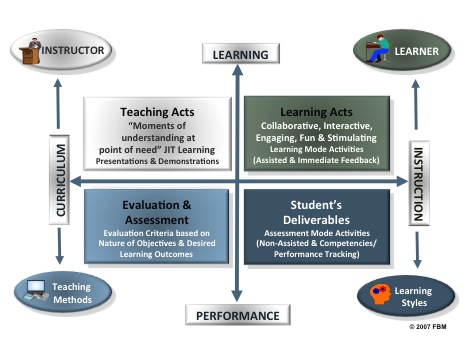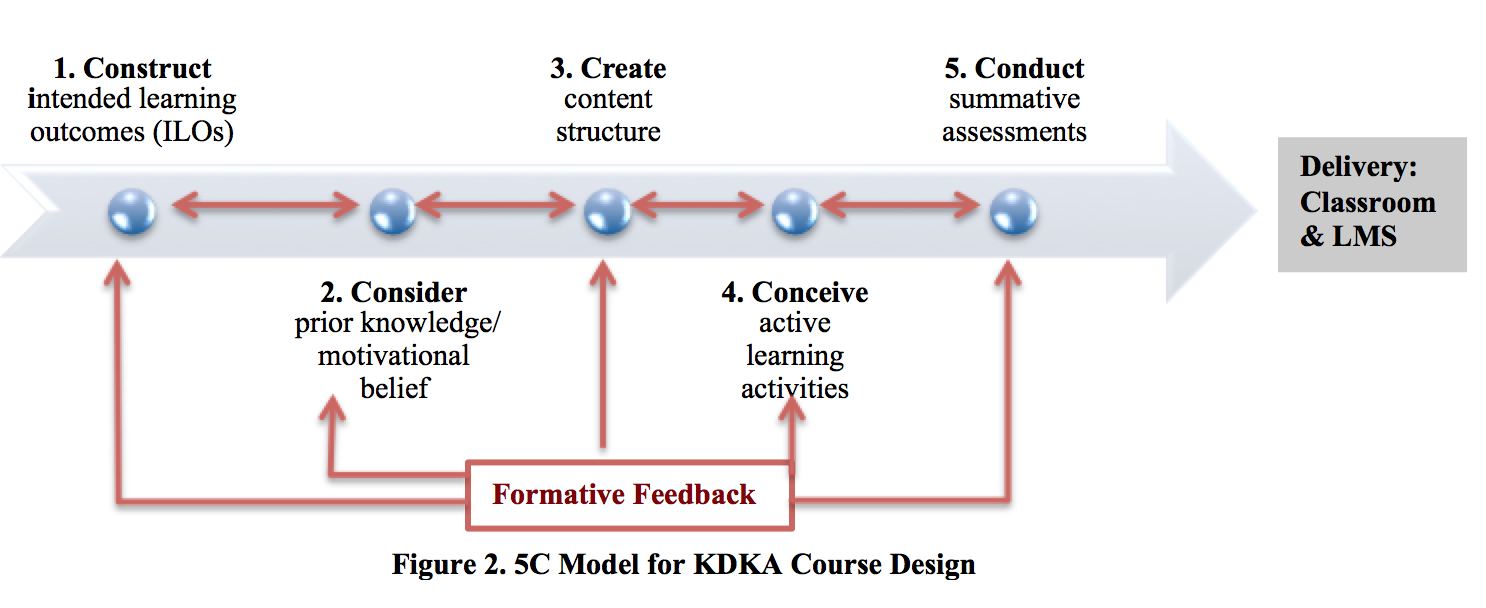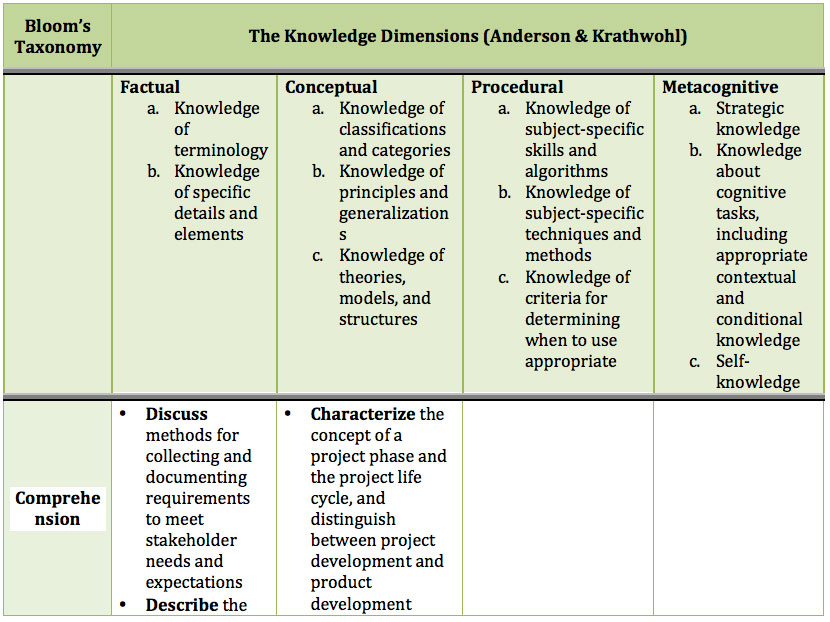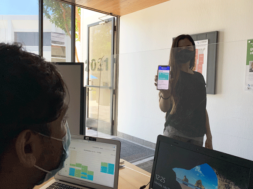
Using Active Learning Pedagogy and the KDKA Instructional Design Model in Curriculum Development
By Fawzi BenMessaoud, School of Informatics & Computing, Indiana University & Purdue University Indianapolis
Abstract: This paper describes the process used to design and develop curriculum using active learning pedagogy and the Knowledge Departed & Knowledge Assimilated (KDKA) Instructional Design (ID) model. The KDKA model approaches instruction and curriculum development in the context of knowledge departed (KD) from the instructor’s side and knowledge assimilated (KA) on the learner’s side. This model affirms that the two sides are interdependent at every stage in the design, development, and implementation of curriculum, including e-learning content. It is based on the concept that every teaching activity is a learning activity but not every learning activity is a teaching activity. By using the KDKA model and digital affordances of the courseware in a given Learning Management System (LMS), the focus was placed on embedding active learning pedagogy and the KDKA instructional design concepts, which includes analyzing learners’ background information, identifying types of content knowledge, constructing intended learning outcomes, designing interactive teaching and learning activities, and developing the evaluation and fitting assessments aligned with the appropriate students’ deliverables. Finally, examples of teaching learning activities and suggestions of active learning strategies are provided to facilitate the design and development of courses and their learning.
It is based on the concept that every teaching activity is a learning activity but not every learning activity is a teaching activity.
Introduction
In today’s educational environments, learning is no longer about the dissemination of data and information as both learners and instructors are drowning in bazillion bits of data and bombarded with super loads of information on a daily basis from various sources targeting their different senses. This reality is no different for education and perhaps it is even more exasperated in the virtual world where the success of electronically assisted instruction does not only hinge on the success of the Learning Course Management System (LCMS) as a delivery platform in terms of functionality and technical navigation but more so on the instructional and pedagogical design of the content being delivered in terms of rigor, depth, presentation, and style.
Here, it should also be noted that while the learning styles have evolved and changed drastically, the teaching styles and methods are by far still lagging behind.
Under this asepsis instructional design and the sophistication of the LCMS are no longer sufficient to proclaim the success of education in the true transfer of information and knowledge between learners and the facilitators. Additionally, all learners that are growing up digital no longer assimilate or even learn the same way, nor can they be taught using the traditional teaching styles and methods. Here, it should also be noted that while the learning styles have evolved and changed drastically, the teaching styles and methods are by far still lagging behind. This phenomenon is also exasperated by the widening gap between learners’ openness and adaptation to technology and innovative high tech devices, tools, and applications versus the integration of technology in instruction and teaching and the adoption of academic technology by teachers.
On this basis I have devised and implemented an applied education model where the essence of learning and teaching is based on Knowledge Departed (KD) from the instructor’s side and Knowledge Assimilated (KA) on the learner’s side (see KDKA Model, Figure-1). This model takes into account at all stage of the design, development, and implementation of education content the existence of two sides that are inseparably and inherently dependent; the instructor side and the learner side along with integrating Educational Technology (ET) in all aspects of both the learner’s and the instructor’s educational experience.
Hence, the KDKA model portrays the relationship between curriculum and instruction in the interrelation between learning and performance where curriculum is to the instructor what teaching methods are to the curriculum just as instructions are to the learner what learning styles are to instructions. Moreover, the KDKA model highlights the fact that every teaching activity is a learning activity but not every learning activity is a teaching activity. Consequently from the instructor side the teaching activities must be designed as just-in-time (JIT) learning where moments of understanding come at the point of the student’s need with fully integrated ET. On the learner’s side the learning activities must then be designed as collaborative, engaging, fun, and most important stimulating and interactive with fully integrated ET.
In this context, the evaluation and assessments activities from the instructor’s side must be based on applying the practice of learner mentoring, monitoring, and measuring of all instructional objectives mapped to student’s deliverables. While on the learner’s side all the student’s deliverables must be designed and delivered using four fundamental education elements and not just one or two. These four essential education elements consist of Instructional Design (ID) and Pedagogical Design (PD) for the content and courseware substance on one side and the Technical Design (TD) and Functional Design (FD) on the LMS side.
Under the KDKA model, the anatomy of any given course would consist of teaching and learning activities built around four fundamental stages of instructional and pedagogical design. The first two stages deal with the teacher side of the equation in the KDKA model where the focus is on teaching activities. Stage one is about lesson presentations or lectures scripted and delivered to introduce and cover the learning objectives through illustration and examples. The second stage supports the first stage by providing demonstrations that emphasize the cognitive elements of what is being explained to the learners and by highlighting the important steps and pitfalls. The last two stages pertain to the student’s side of the KDKA mode where the focus is on learning activities that ultimately leads to two modes of student learning where assessment is mapped to the student’s deliverables. Here, the students would be either engaged and interacting in an assisted learning mode where feedback and coaching is immediate, or in an assessment mode where their competencies and performance are being observed, measured, and tracked for more feedback and revisions to the teaching activities that would then reshape the learning activities.

Designing courses using the KDKA & the 5C Design Model
The affordances from traditional learning environments (e.g., lectures, note-taking format, or content delivery) basically provide limited opportunities for students to perceive new information, pay attention, interact with each other and the teachers, and perform academically. However, with the use of the KDKA to create active teaching and learning and the trend of the technology transformation, digital learning environments present new opportunities for students to embody and facilitate their own learning. These digital technologies all share one characteristic – they provide non-linear affordances for learners to perceive, act upon, and interact with learning environments and to construct their own knowledge along the assimilated knowledge from their teachers with authentic examples from the real world.
Smith & Ragan, 2001 asserted that the essence of instructional design is to connect the actual instruction and learner-initiated actions, the “middle ground” should explore the balance between instructional strategies and learning strategies to facilitate the required cognitive processing. Specifically, according to Reigeluth (1999), effective instruction should include elements that foster cognitive learning: clear information, thoughtful practice, informative feedback, and strong intrinsic or extrinsic feedback. By integrating the KDKA instructional design model and digital online learning, the following 5C model (see figure 2) is introduced to restructure and redesign the teaching/learning activities and the assessments and students’ deliverables for two courses; I202 Social Informatics and I402/N420 IT Project Management based on IUPUI course delivery and its Canvas learning platform.

1. Learning context analysis → Construct intended learning outcomes
The first step was to define and construct the intended learning outcomes (ILOs) describing the terminal behaviors for students to be able to demonstrate or achieve at the end of the course using the KDKA principles and according to Bloom’s taxonomy (1956), which provides a theory-based guide to classify ILOs with specific, measurable, and observable descriptions. The main KDKA principle is to place more focus on learning activities rather than teaching and to construct the ILOs based on the dimension of knowledge, the goals of the programs or the Computing and Informatics department and its teaching-learning settings, and the instructional objectives of the Informatics curriculum. Table 1 shows a matrix with examples from a course based on Bloom’s taxonomy and the KDKA principles.

2. Learner analysis → Consider cognitive prior knowledge and motivational beliefs
After constructing the ILOs for the two courses, the next step was to understand the target audience’s characteristics including cognitive ability (e.g., prior knowledge) and motivational beliefs (e.g., individuals’ goals, self-efficacy, or attribution). Two First Day of Class (FDC) and first week course activities were constructed to get a precise understanding of learners’ characteristics through direct conversation and observation. The activities were designed to use basic instruments to collect the related information from the target learners, including the use of the 4D1 cognitive questionnaire and a mind mapping activity with Popplet to measure students’ prior knowledge, goals of enrolling in the two course, self-efficacy for completing certain course tasks, or attributions when they encounter learning experiences of success or failure that can be used to adjust the ILOs to meet students’ needs.
3. Learning task analysis → Create content structure
To optimize the affordances of both on campus resources and the Canvas online technology and the students’ effectiveness/abilities, several types of instructional structure are used to effectively engage in teaching-learning settings based on the analyses of students and learning context. In both the I202 and the I402/N420 courses the following learning activities aligned with the weeks ILOs are created for each week:
• In-class problem-based activities followed by a scenario or case analysis activity started in class and delivered in Canvas aimed at increasing the students’ self-awareness of knowing that learning certain subject or content knowledge is important to them and why it is important for their future.
• Project-based activities based on real-world scenarios and tied to the completion of a final course project (capstone if applicable). Each part of the project is tied to the week’s discussions, presentation, and ILOs with the project deliverables as building steps.
4. Instructional strategies design → Conceive active learning activities
To promote active learning as a process whereby students engage in learning activities that promote application, analysis, synthesis, and evaluation of new knowledge of course contents as described by Prince, each week’s teaching strategy will include the following learning activities to actively engage students in the learning process:
• Two sequential, cause-effect, and discussion-based activities each week started in class and completed in Canvas.
• In-class learning activities designed with the unique features of both problem-based and self-regulated learning and peers interaction and collaborations aimed to improved interpersonal skills with digital affordances.
• Group discussions activities tied to case studies/case analysis and the students’ reflective writing and reporting.
• Self-assessment activities to promote active learning in an assisted mode and motivate students to engage in critical thinking.
(See Table 2 for examples of learning activities.)
5. Assessment and evaluation development → Conduct assessments
To evaluate students achievement and mastery of the courses’ ILOs, both formative and summative assessments are constructed and scheduled according to an alignment with the weekly presentations, learning activities, and discussions. In addition to the following list of assessments and student deliverables, a final course activity is constructed with an exit questionnaire to compare the students’ characteristics and learning assessment after completing each course.
Assessment Categories
- Discussions & Participation
- Homework/Learning Activities
- Case Analysis
- Non-cumulative Exams
- Research Assignments & Trend Reports
- Final Course Project/Capstone
- Final Exam

DR. FAWZI BENMESSAOUD, has been involved in higher education for over 30 years as an educator, administrator, and academic leader both at the campus and corporate level. He holds a B.S. in Computer Technology, an M.B.A. in Information Systems, and a Ph.D. in Information Technology. Dr. BenMessaoud is an active accreditation team chair and evaluator and has been serving on the Intermediate Review Committee (IRC) for the National Accreditation Organization (ACICS) in Washington DC, since 2001.
Dr. BenMessaoud has worked for several years as an Intelligence Analyst prior to being selected by the FBI as a special agent. He has conducted several technology integration programs and has designed, developed, and successfully mapped an Information Security Systems program to the NSA Information Assurance standards that received the NSA CNSS approval in 2007. Dr. BenMessaoud has directed several teams to design, develop, and deliver content, including interactive learning and assessment materials at all academic levels. He worked directly with Jack Welsh and designed the Jack Welsh MBA program that later became the Jack Welsh Management Institute. Dr. BenMessaoud has designed and integrated lab simulation to deliver Information Security System courses online. This project was selected among top 101 Best Practices in Integrating Technology with Higher Education for 2005 by Campus Technology magazine. He has also presented at several International and world conferences on instructional technologies, educational media, and technology Integration, including Australia, Finland, Austria, Portugal, England, Canada, and Singapore.
Contact Information: Fawzi BenMessaoud // School of Informatics & Computing // Indiana University & Purdue University Indianapolis // fawzbnem@iupui.edu
References
Anderson, L. W., & Krathwohl, D.R. (Eds.). (2001). A taxonomy for learning, teaching and assessing: A revision of Bloom’s Taxonomy of educational objectives: Complete edition, New York: Longman.
Bloom, B.S. and Krathwohl, D. R. (1956) Taxonomy of Educational Objectives: The Classification of Educational Goals, by a committee of college and university examiners. Handbook I: Cognitive Domain. NY, NY: Longmans, Green.
Gallego, M., & Hollingsworth, S. (1992). Multiple literacies: Teachers’ evolving perceptions. Language Arts, 69, 206–213.
Graham, S., & Weiner, B. (1996). Theories and principles of motivation. Handbook of educational psychology, 4, 63-84.
Ho, A. D., Chuang, I., Reich, J., Coleman, C. A., Whitehill, J., Northcutt, C. G., Williams, J. J., Hansen, J. D., Lopez, G., & Petersen, R. (2015). HarvardX and MITx: Two Years of Open Online Courses Fall 2012-Summer 2014.
Ho, A. D., Reich, J., Nesterko, S., Seaton, D. T., Mullaney, T., Waldo, J., & Chuang, I. (2014). HarvardX and MITx: The first year of open online courses (HarvardX and MITx Working Paper No. 1).
Leu, D.J., Forzani, E., Rhoads, C., Maykel, C., Kennedy, C., & Timbrell, N. (2015). The new literacies of online research and comprehension: Rethinking the reading achievement gap. Reading Research Quarterly, 50. 1-23. Newark, DE: International Reading Association. doi: 10.1002/rrq.85.
Prince, M. (2004). Does active learning work? A review of the research. Journal of Engineering Education, 93, 223-231.
Reigeluth, C. M. (1999). What is instructional-design theory and how is it changing. Instructional-design theories and models: A new paradigm of instructional theory, 2, 5-29
Smith, P. L., & Ragan, T. J. (2001). Conditions-based models for designing instruction. (Jonassen, Ed.) The Handbook for Educational Communications and Technology, 623-644










